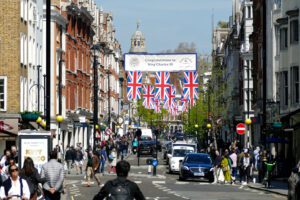Have you watched Bridgerton lately? Are you also a fan of the Sherlock Holmes adaptation with Benedict Cumberbatch? Do you remember Stanley Kubrick’s epic Barry Lyndon or James Ivory’s drama The Remains of the Day? Apart from great actors, all of these films and series intrigue with enchanting backdrops. Aren’t those mansions with manicured front lawns and gently rolling hills in the backdrop not simply gorgeous? It would be just wonderful if these beautiful sets existed in reality!
Well, good news: They are real!
Whenever a director needs a flawless Georgian or Victorian setting, he’ll probably end up in Bath at some point. And that’s not surprising as Bath is arguably the most beautiful town in all of Great Britain, after all. Even UNESCO agreed and quickly listed the entire city as a World Cultural Heritage Site in 1987.
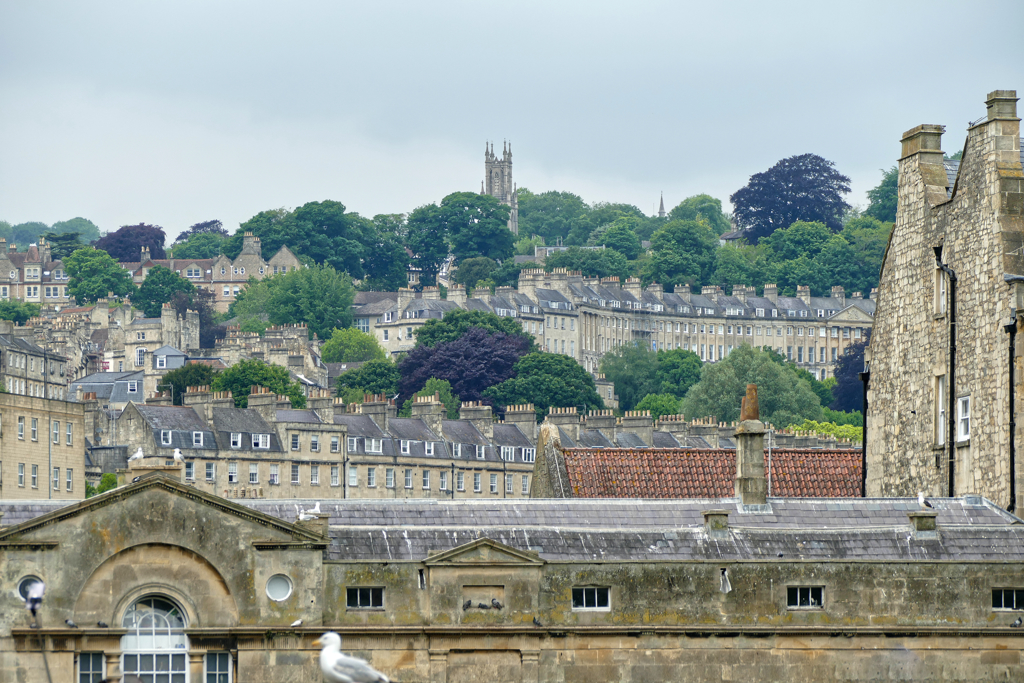
Bath – Beauty Through the Ages
The city of Bath owes its founding to thermal springs. The principal source was already known to the Celts, who dedicated it to the Goddess Sulis. After the Romans conquered the British island in 43, they built a settlement including thermal baths according to the Roman model. They called the place Aquae Sulis, synonymous with the Goddess Minerva. To this day, Bath’s Roman bath and remains of the temple complexes help us to trace and comprehend the social and religious structures of ancient Roman society.
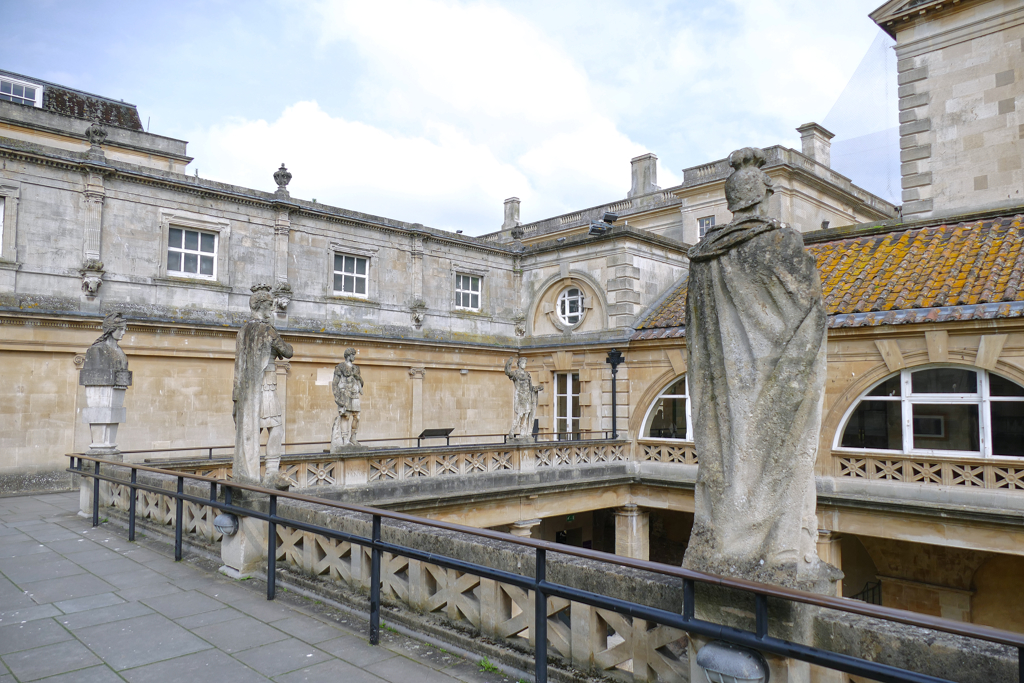
In the Middle Ages, Bath became an important wool industry center. However, in the 16th and 17th centuries, the aristocracy came to Bath for treatment and made the city a popular place. Even Queen Anne of England visited Bath in 1702.
Then, Bath experienced its second heyday under the reigns of Georges I, II, and III. when it developed into an elegant city famous for literature and art in the 18th century. Ambitious architects such as John Wood the Elder and John Wood the Younger set themselves the task of making Bath one of the most beautiful cities in Europe.
Gentlemen, mission accomplished!
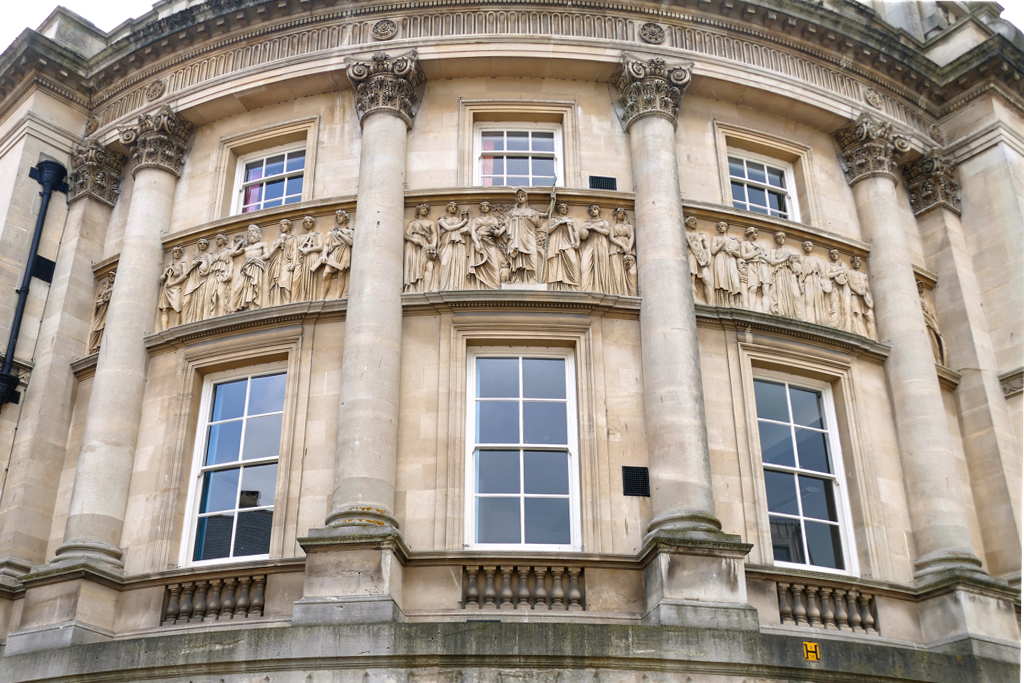
However, the individual Georgian mansions designed by Robert Adam, Thomas Baldwin, and John Palmer, for example, clearly show the influence of the Italian Renaissance architect Andrea Palladio, who was active during the Venetian Republic in the 16th century.
Bath’s magnificent neoclassical crescents, terraces, and squares stretching from the city center over the surrounding hills showcase a perfect combination of architecture, urban design, and landscape design.
Hence, it’s not just the exquisite and sophisticated architecture that makes Bath the most beautiful city in England. It is also its fantastic location between grass-covered hills, meadows, and park-like areas.
Bath – The Grand Tour
I think I’ve raved about Bath’s beauty enough, now you’ll want to get to know this incredible place for yourself, am I right?
Hence, let me take you on a grand tour.

Bath is mighty but small. You can explore the entire city in one day, especially during the summer months when the days are much longer. That doesn’t mean that after one day, it will get all dull’n’tedious. Keep in mind that Bath is a SPA so relaxing strolls through the city with long tea breaks are a vital part of the overall experience. Long walks across the lush green meadows of the surrounding hills and an extensive SPA soak are also recommended activities. While you can see Bath in one day, you’ll need more time to really immerse yourself in that soothing experience.
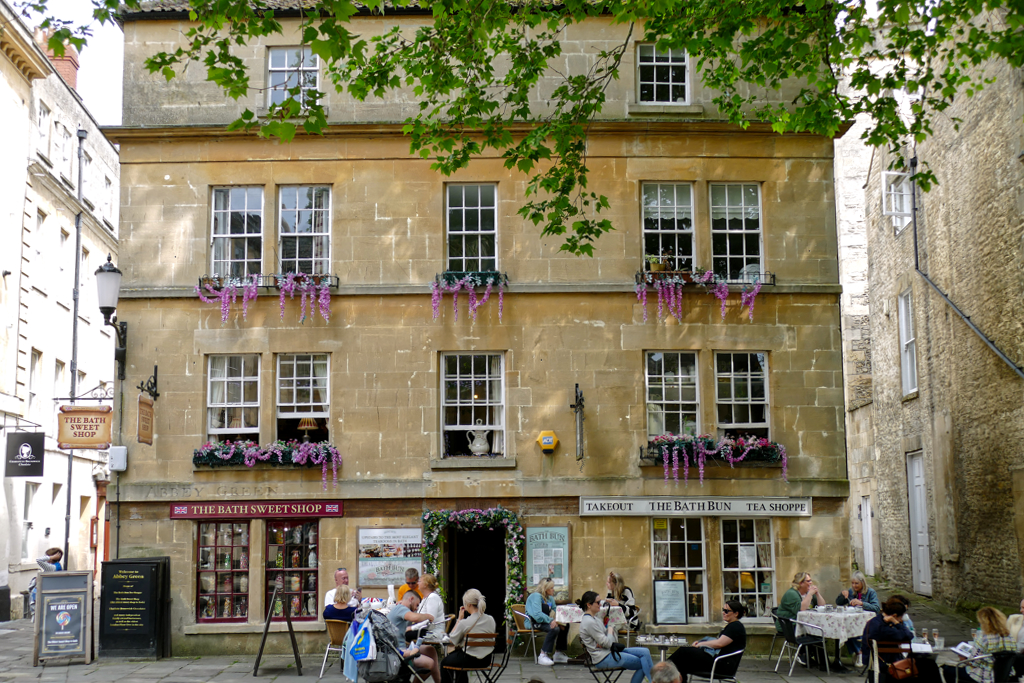
Nevertheless, I was in England’s so-called Mild Mild West, namely in Bristol, for a long weekend. Therefore, my visit to Bath was just a day trip, and in this post, I’ll share what amazed me the most.
The Roman Bath
Although there are many SPA treatments available in Bath to this date, the one bath that gave Bath the name Bath is not one of them. Yet, the ancient Roman thermae is indisputably the most iconic landmark and no trip to Bath would be complete without a visit.
I was told to get there as soon as they opened at 9 a.m., and I’m very happy to have followed the advice as the first large tourist groups followed on my heels. So do yourself a favor and take an early ride to the city, especially on weekends.
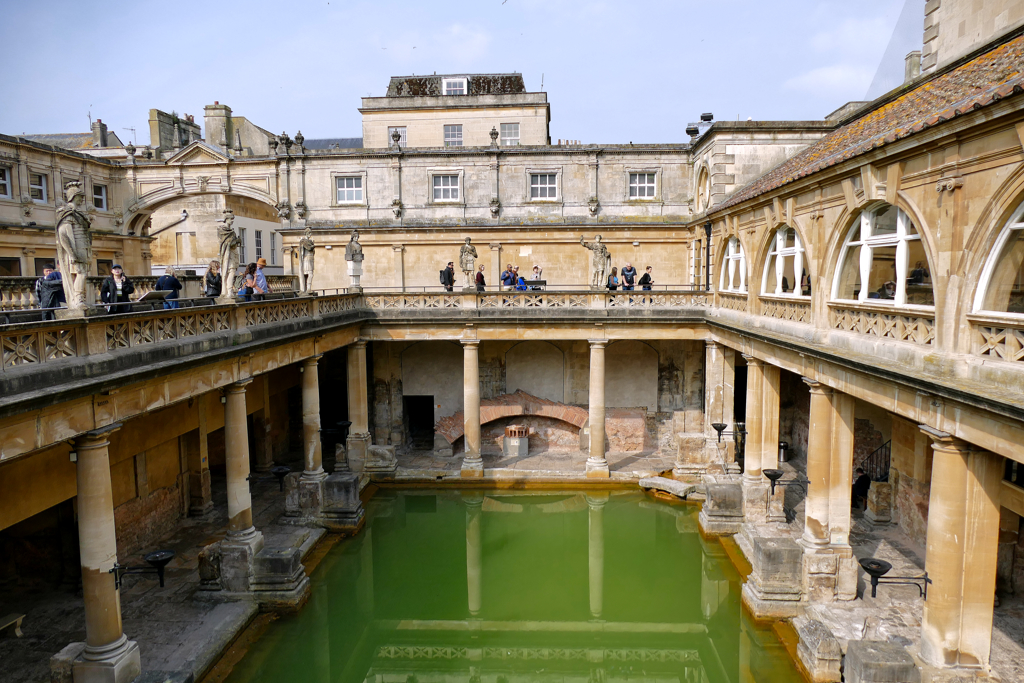
The Romans built this magnificent bathhouse at the end of the first century. It was probably in use until the early 5th century. During this time it was further expanded and renovated. The center of the thermal baths was a large pool surrounded by columns and lined with lead. To the east and west, there was a smaller water basin as well as smaller rooms for various purposes such as changing clothes.
An inflow led the thermal water into the main pool of the bath. A drain flows into the nearby River Avon.
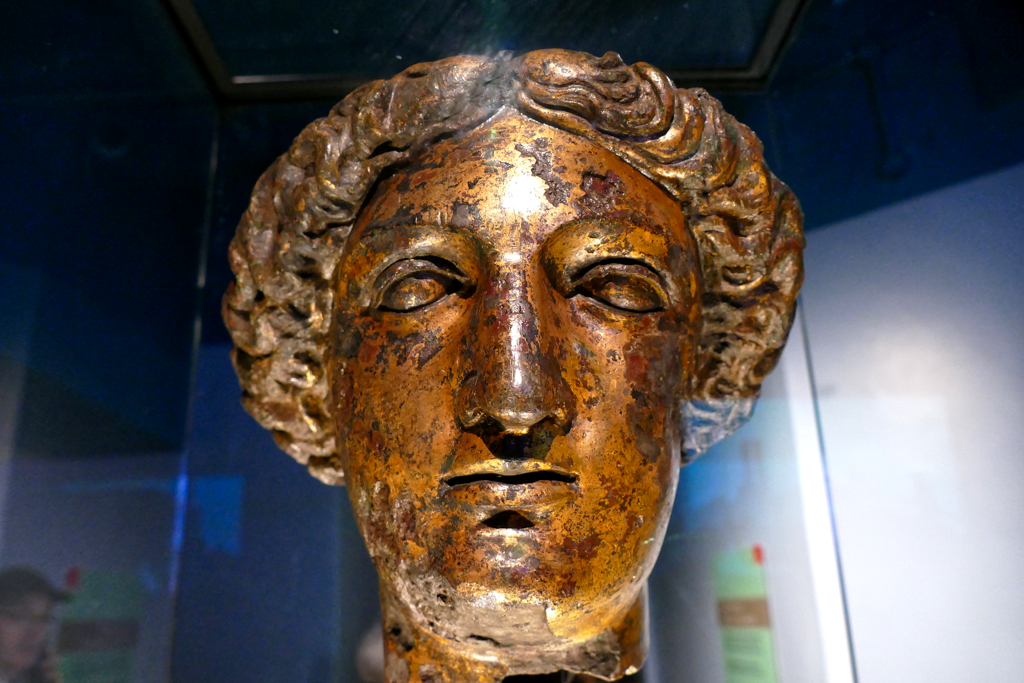
The water source was considered sacred. Here visitors to the baths could come into contact with the goddess Sulis Minerva. They also threw messages and small offerings into the spring. While the heavy objects immediately sank to the ground, lighter objects were often washed through the sewers. Thousands of these votive offerings were found during excavations in the late 19th century.

In the fourth century, the River Avon repeatedly overflowed its banks and flooded parts of the city. The thermal baths in particular were severely affected. Sand and garbage from other parts of the city covered the floor of the temple area.
Roman Times Revisited
The Roman remains were discovered in the Victorian era and excavations began in 1878. They continued into the 20th century. Today the baths are among the best documented buildings in Roman Britain.
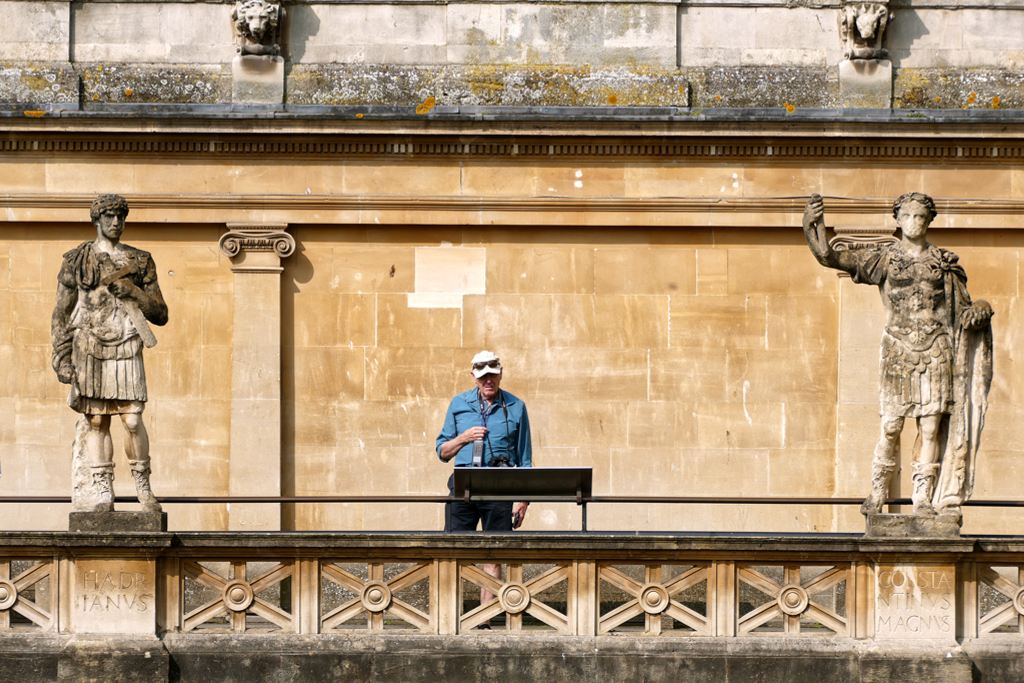
Depending on the season and day of the week, the thermal baths open at 9 or 10 a.m. and close between 6 and 8 p.m. A standard entry ticket costs £27, but there are different packages available. Be sure to check out their website to plan your visit. There you can also book a ticket for a specific timeslot and thus avoid long waiting times.
Bath Abbey
Right next to the Roman thermal baths is another magnificent historical building, namely the Abbey Church of Saint Peter and Saint Paul. The former Bath Abbey Church was originally the church of a Benedictine monastery. Today it is an Anglican parish church and the episcopal see of the Diocese of Bath and Wells.

In 1088, around two decades after the Norman conquest of England, an episcopal church was built in the Anglo-Norman style. This was badly damaged and had to be reconstructed in the late 15th century. The Cathedral then passed to the English royal family after the Act of Supremacy which declared the English monarch the Supreme Head of the Church of England and initiated the English Reformation.
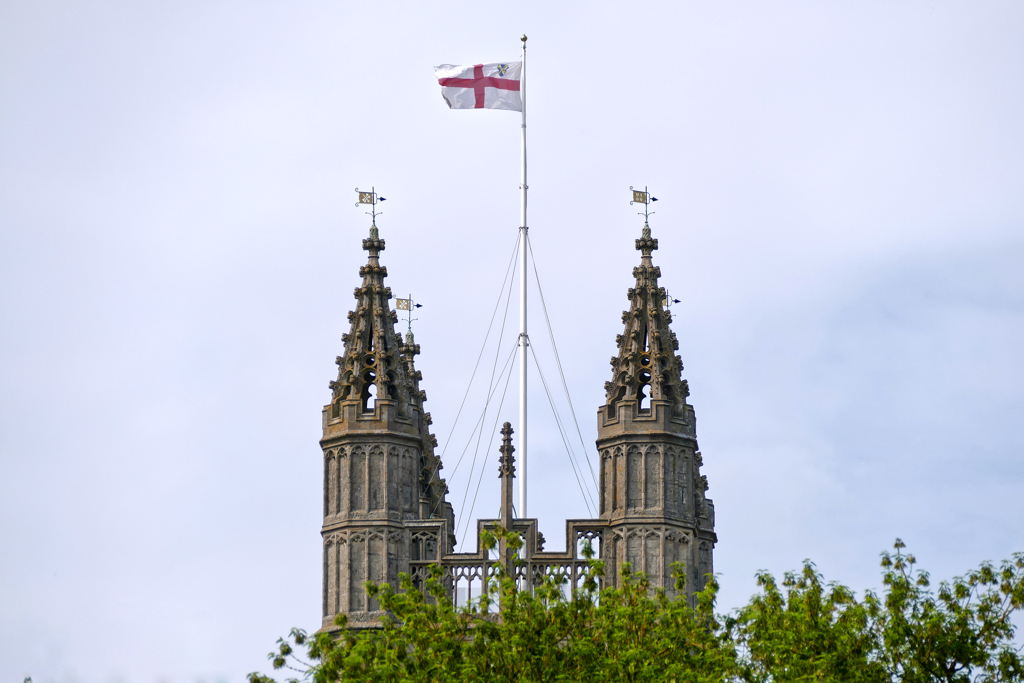
Those who are good on foot can, among other things, climb the 212 steps of the Bath Abbey Tower on a guided tour and enjoy a picturesque panoramic view of the city and far beyond. This tower tour lasts just under an hour and is available all day during the opening hours for an additional charge of £15.
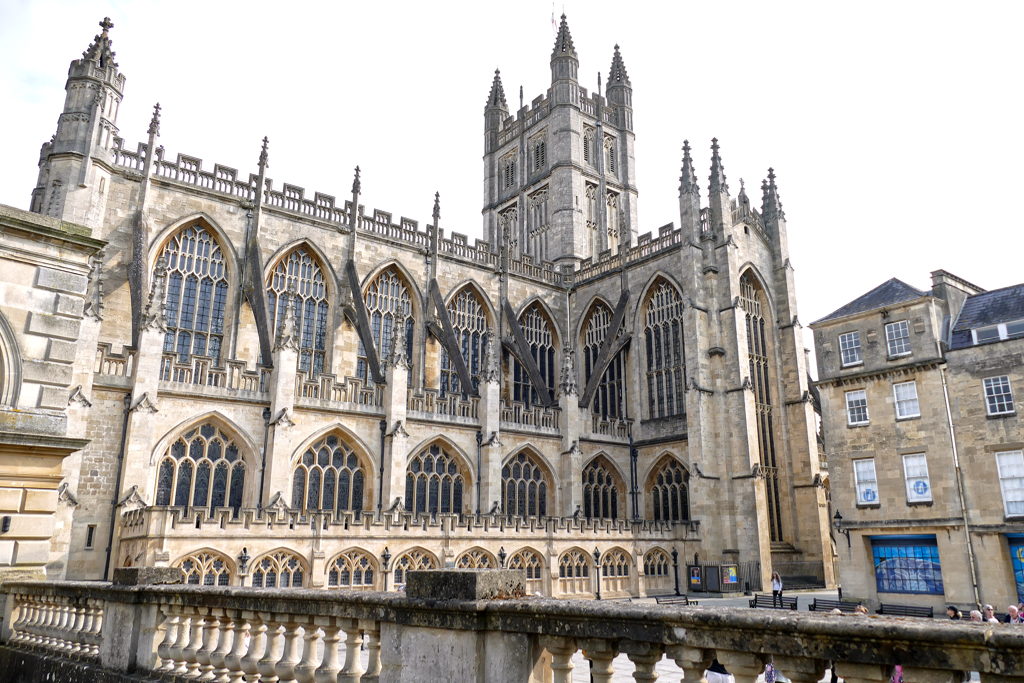
A visit to Bath Abbey is possible from Monday to Friday between 10 a.m. and 5.30 a.m., Saturdays even until 6 p.m. On Sundays, they are open for tourist visits from 1.15 p.m. to 2.30 p.m. and then again from 4.30 p.m. to 6.30 p.m. A single ticket costs £7.50.
Two Comprehensive Bus Tours
Of course, it is certainly possible to discover Bath yourself on long walks. But to give your legs a little break and still continue your tour, there’s nothing better than a ride on the Toot Bus. This bus, which also carries visitors through Brussels, Paris, London, as well as Bath, runs tirelessly between 9.30 or 10 a.m. and 3.30 and 6.30 p.m., depending on the route and the season, at intervals of around 20 minutes. I highly recommend checking their website and downloading their App from the Google Play Store or the Apple Store when planning your trip.
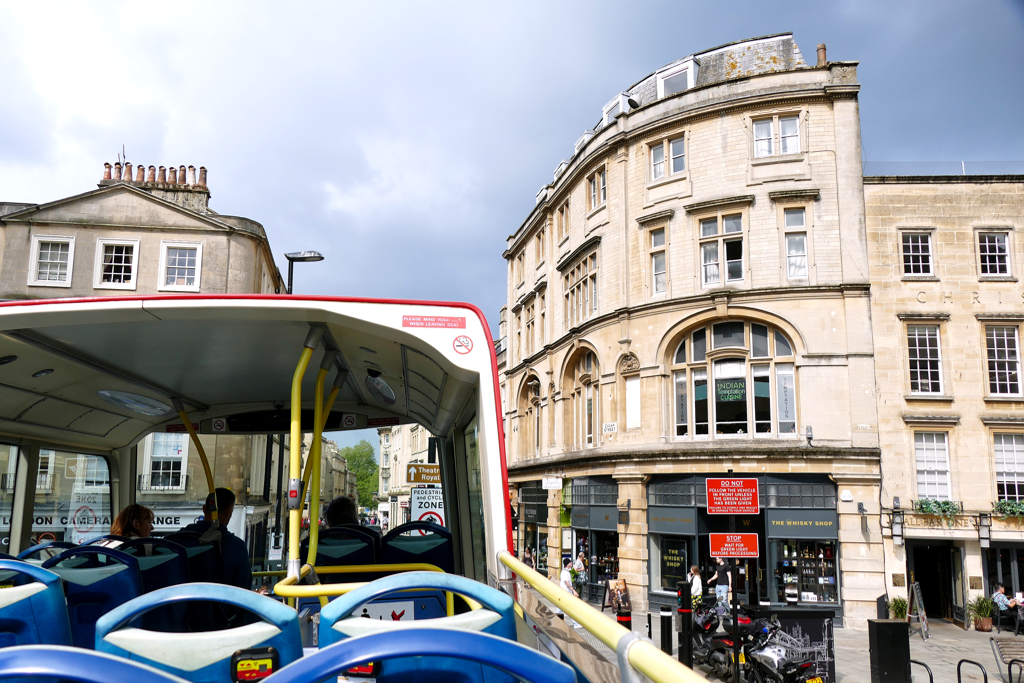
Another advantage is the explanations and comments provided in several languages. Driving through a city as steeped in history as Bath and not learning anything about the history and background would really only be half the fun.
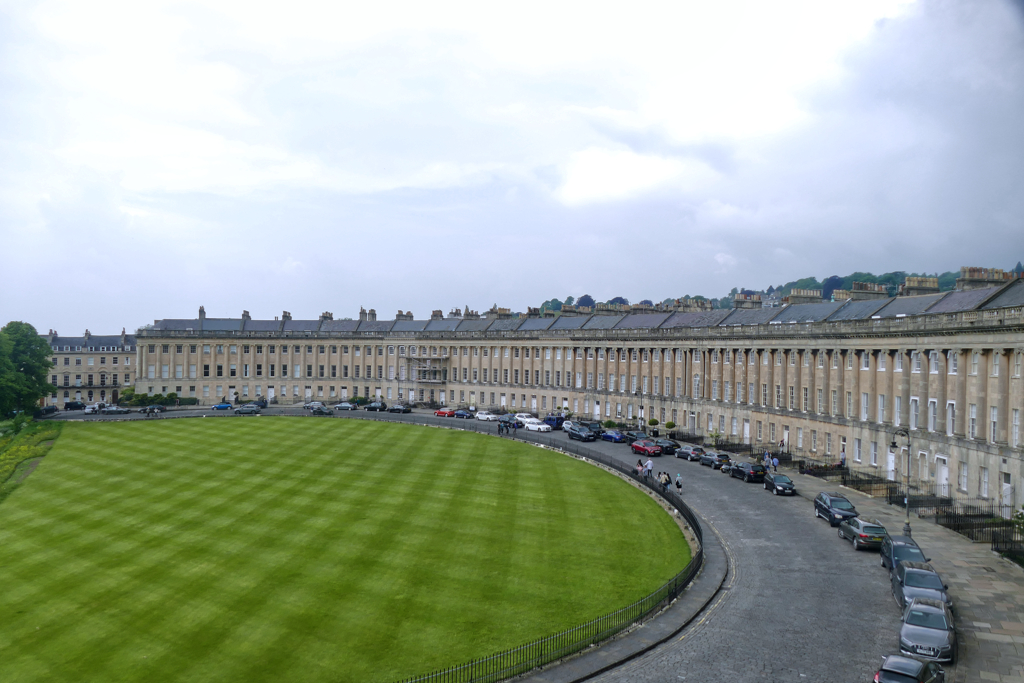
Of course, no one is stopping you from still exploring Bath on foot. For example, I first did a complete city tour and then calmly went to the places that interested me most, such as the Royal Crescent and especially the house museum at Number One. Then I just took the next Toot bus back to the center.
Bath And Beyond
The Skyline bus tour, which is also included in the ticket, is particularly recommended. This tour takes you out of the city and over the hills and through the green countryside southeast of the center. Here, too, you can get off wherever you like and, for example, take a pleasant walk in Prior Park Landscape Garden and admire the beautiful Palladian Bridge. The next Tootbus** will take you back to the city center.

A general single ticket costs £23.50 and is well worth the money, especially on a day trip where time is a precious commodity.
There are several options such as family tickets and tickets that include a visit to a tourist attraction. As I said, it’s best to check their website before your visit. Also, if you buy your ticket online, you get a 15 percent discount.
Jane Austen
Although Jane Austen is not from Bath and only lived in the city for five years, she seems to be at least as much of a figurehead for Bath as Elvis Presley was for Memphis – and he didn’t originally come from there either as he was from Tupelo.
Jane Austen was actually born in 1775 in Steventon, Hampshire, the seventh of eight children, where her father William George Austen was a clergyman. Little Jane had access to her father’s library and began her first literary attempts at the age of twelve.

In fact, Jane Austen did not move to Bath with her parents and an unmarried sister until 1801, where she lived until 1806. However, the city inspired two of her six published novels, namely Northanger Abbey and Persuasion.
Nevertheless, a visit to the Jane Austen Center seems to be an integral part for every visitor to Bath. This beautifully designed center on Gay Street takes romantics back through Jane’s time in the city. Hardcore fans can even dress up in a Regency costume and have refreshments in the Regency Tea Rooms after a tour of the house. However, it’s all recreated according to the motto That’s how it was at that time. The exhibits didn’t belong to the writer. You should be aware of this when visiting.
I guess you can already tell: Since Jane Austen’s stay in Bath was relatively short and, realistically speaking, she didn’t leave any deep traces there, everything now has to be forced into a Jane Austen-ish corset.
This hype reaches its peak in September when the ten-day Jane Austen Festival takes place and the city sinks into Regency madness. Year after year, an extensive festival program celebrates five years of Jane Austen’s 41-year life.
The Jane Austen Center is open daily from 9:45 a.m. to 5:30 p.m. A single ticket costs £15.75 if you buy it online.
The Circus
The so-called Circus is a circular building complex and consists of 33 terraced houses. John Wood the Elder designed this urban housing project in the mid-18th century. Although he laid the foundation stone in 1757, he couldn’t finish his assignment as he passed about three months later. The project was then executed by his son John Wood the Younger.
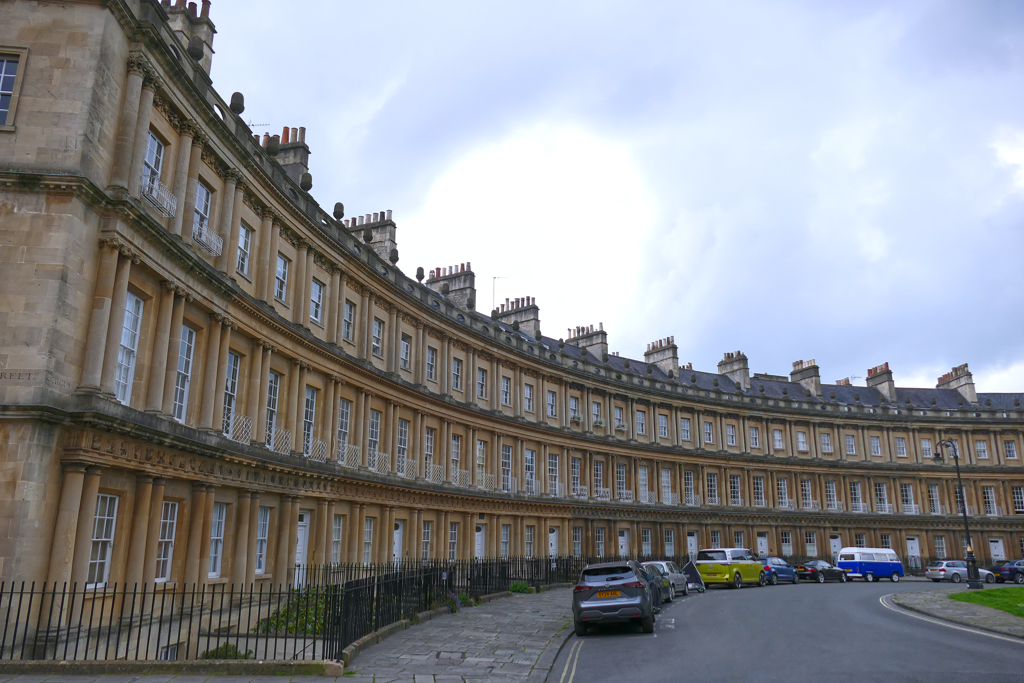
The overall complex, whose design was influenced by both the Colosseum in Rome and the megalithic stone circle at Stonehenge, forms a circle that is only interrupted by three street junctions.

The houses, all of the same design, have a basement and three floors above ground. All façades are structured by double columns with the Doric, Ionic, and Corinthian capitals typical of classicism. The interior of the circle was originally planned as an open space. But in the early 19th century, residents landscaped the roundabout.
Royal Crescent
John Wood the Younger not only carried out the circus planned by his father. Just 300 meters from the architectural masterpiece, he created his own chef-d’oeuvre, the Georgian-style Royal Crescent, completed in 1774.
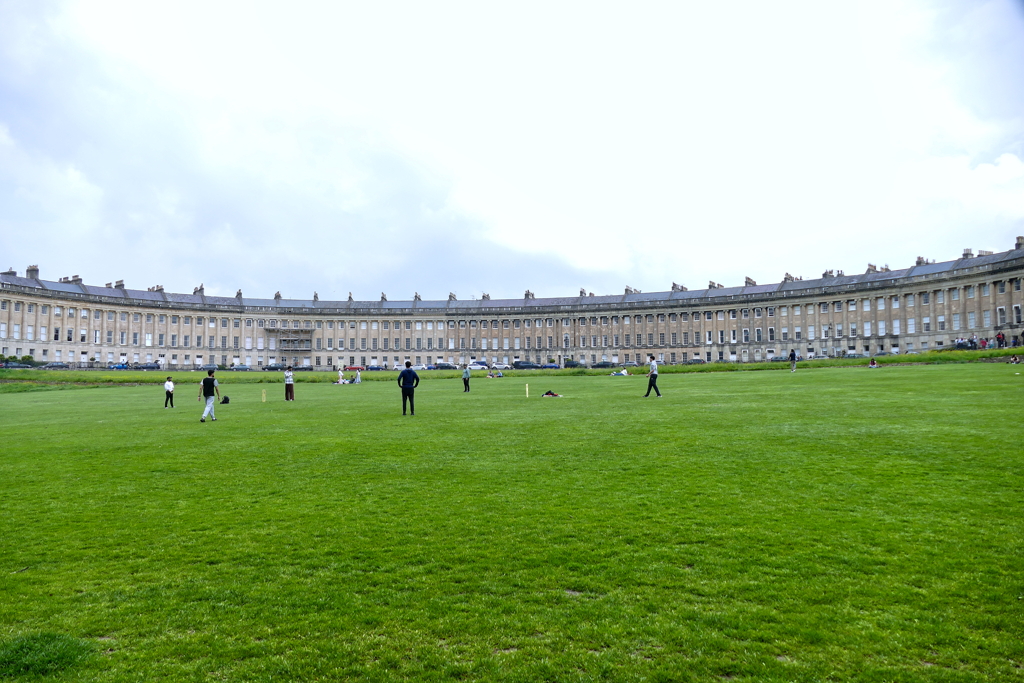
The building complex consists of 30 houses lined up in a semicircle with Ionic columns in front. The entire arrangement looks like a palace. Behind the windows on the middle floor, framed by half-columns, were the staterooms, and above them the master bedrooms. The servants’ quarters were located under the roof, where very little light penetrated through small windows. The storage and utility rooms such as the kitchens were in the basement. The initially open view from the Royal Crescent, a key element of the design, has been altered through the subsequent development of Bath. Nevertheless, the concept is partly preserved in the form of what is now Royal Victoria Park.
Even if you’ve never visited Royal Crescent, it might look familiar. For decades, the impressive row of houses has served as an authentic background in television shows and movies such as the miniseries The Pursuit of Love and the film adaptation of Jane Austen’s novel Persuasion.
Most recently, the particularly illustrious city palace Royal Crescent No. 1 served as the exterior façade of the Featherington family home in the Netflix series Bridgerton.
Royal Crescent No. 1
In the row of mansions on Royal Crescent, building No. 1 has a special function. It was the first of the thirty houses to be built. The first resident was the wealthy landowner Henry Sandford. He lived at the house for twenty years until his death in 1796. Money makes money: When Sandford was absent for a while, he rented the villa out to clergy and lower nobles as a summer residence at exorbitant rents.

In 1968, the house was separated from its commercial wing, which became known as No. 1a. The main part was offered for sale. Bernard Cayzer, a member of the family that owns the Clan shipping line, bought it and eventually bestowed it to the Bath Preservation Trust. In addition, Cayzer provided funds for restoration so that it could open as a Georgian townhouse museum. It also houses the offices of the Bath Preservation Trust.
The interior design of the house was undertaken by a distinguished committee including the Victoria and Albert Museum and the famous interior designer Jean Munro. The collections include historical fittings to replace some lost or replaced parts. The window sills on the first floor were raised to their original height, joinery was replicated and a new back staircase was built.
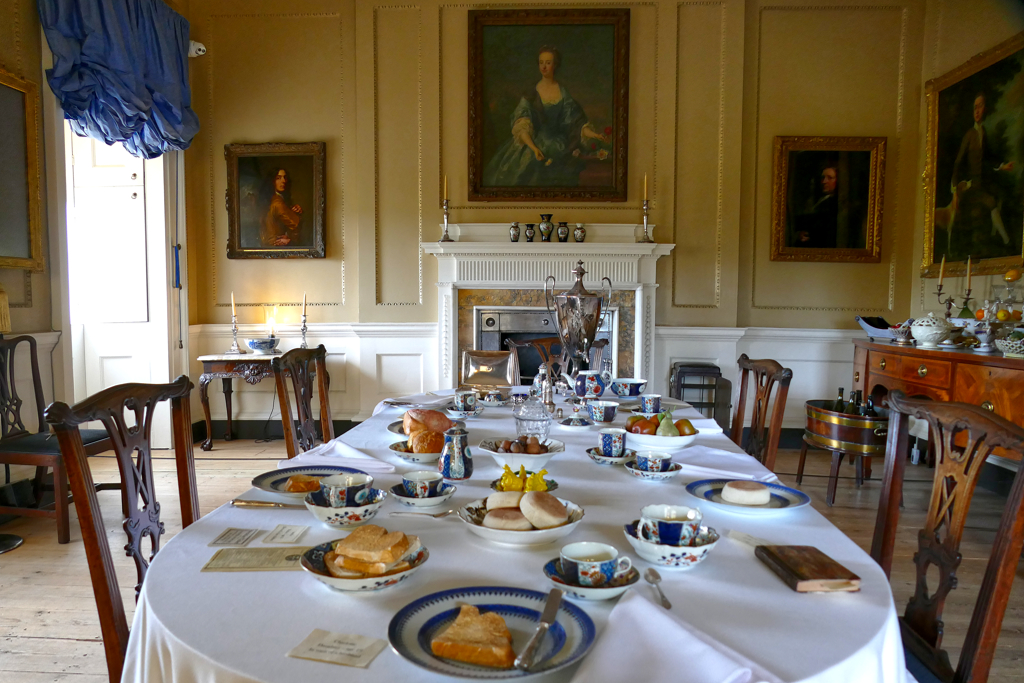
Another major renovation project was completed more recently when the main house was reattached to its original service wing #1a.
The museum opened in its current form in 2013.
After admiring the architecture of both the Circus and the Crescent from the outside, this house museum grants a look behind literally closed doors which is an excellent way to apprehend’n’appreciate the architectural gems in all their splendor.
Royal Crescent No. 1 is open from Tuesday to Sunday between 10 a.m. and 5.30 p.m. The general entrance fee is a whopping £15.50.
My Tip:
This is a good opportunity to point out that, in contrast to many countries in continental Europe, museums in England tend to close rather early, often as early as 5 p.m. So keep that in mind when planning your visit to Bath.
Pulteney Bridge
The Pulteney Bridge was designed by the Scottish-born and London-based architects Robert and James Adam and completed in 1774. It is one of the few bridges in the world lined with shops. Other famous examples are the Ponte Vecchio in Florence and the Ponte di Rialto in Venice, obviously. That makes total sense as the Adam brothers constructed the bridge, which is only 45 meters long, based on Italian pinnacles.
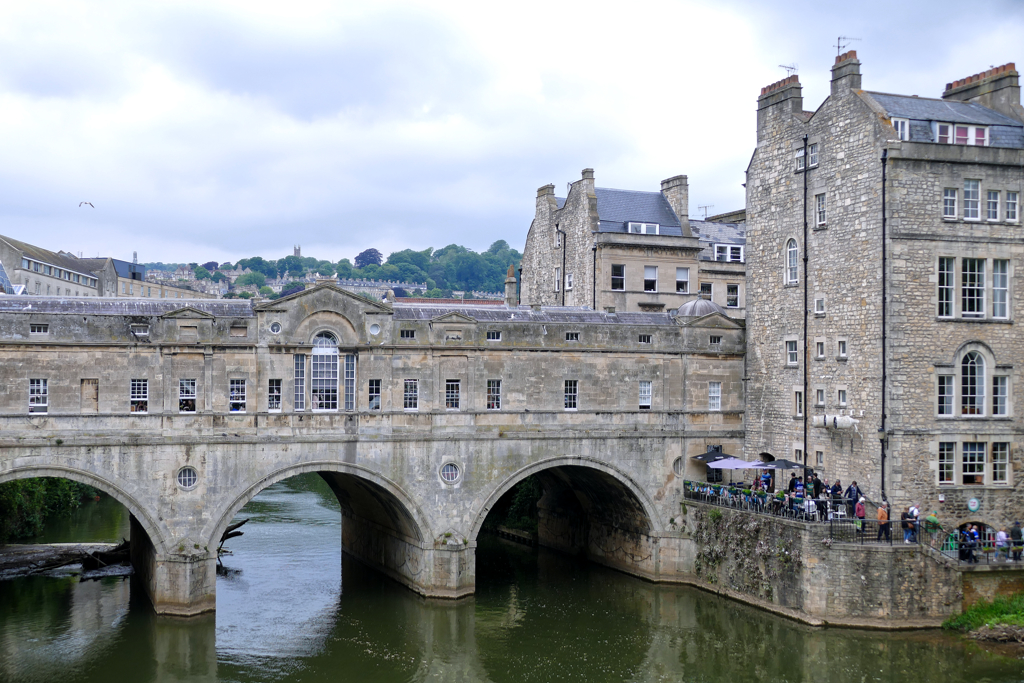
Until the bridge was completed, the center of Bath could only be reached from the north or by ferry. After two substantial inheritances from the Earls of Pulteney, the Bath-based Johnstone family changed their surname and used some of their funds to commission the bridge. Since the bridge was the only one in Bath for a long time, the traffic was correspondingly high. The shops on the bridge made excellent profits.
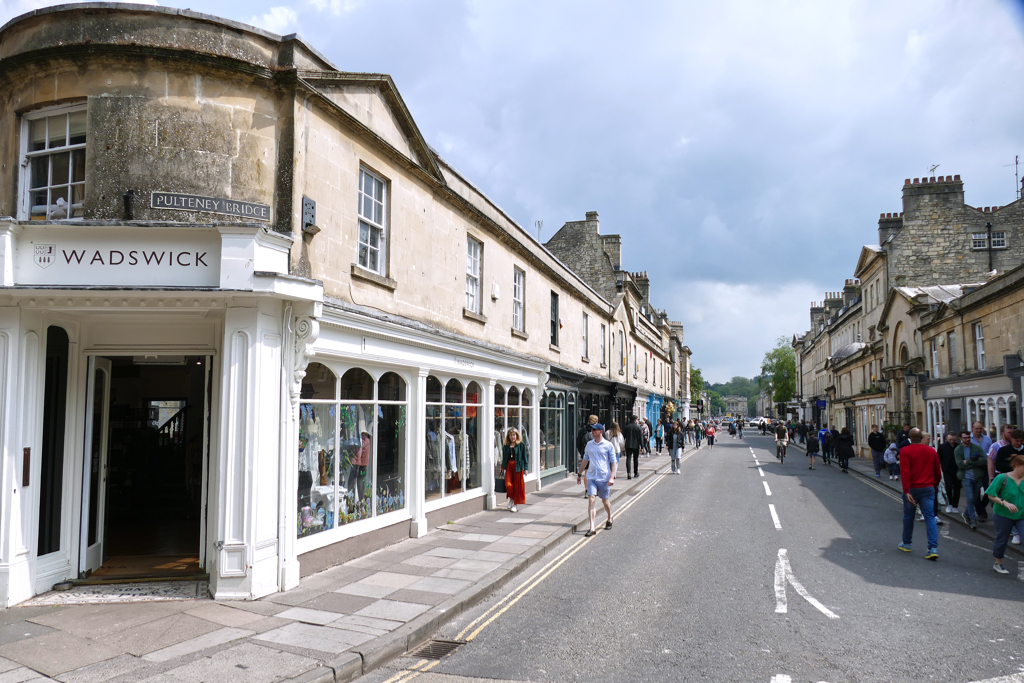
Today, individual cars are not allowed on the bridge to avoid damage and accidents. Only buses and taxis are allowed to cross.
Great Pulteney Street
Great Pulteney Street is an imposing boulevard that connects Bath with Bathwick east of the River Avon. From the city side of the bridge, the road leads straight to the former Sydney Hotel, which was once the elegant meeting place of Bath’s high society. Jane Austen is also said to have had breakfast here regularly before going for a walk in the adjacent Sydney Gardens. Today, it houses the Holburne Museum of Art.
Sir William Pulteney commissioned the architect Thomas Baldwin to design this magnificent boulevard. It was completed in 1789. In fact, this was a win-win coup: The city intended to expand its borders anyway, and Pulteney’s estate was across the River Avon and the new avenue granted him a better connection to the center.
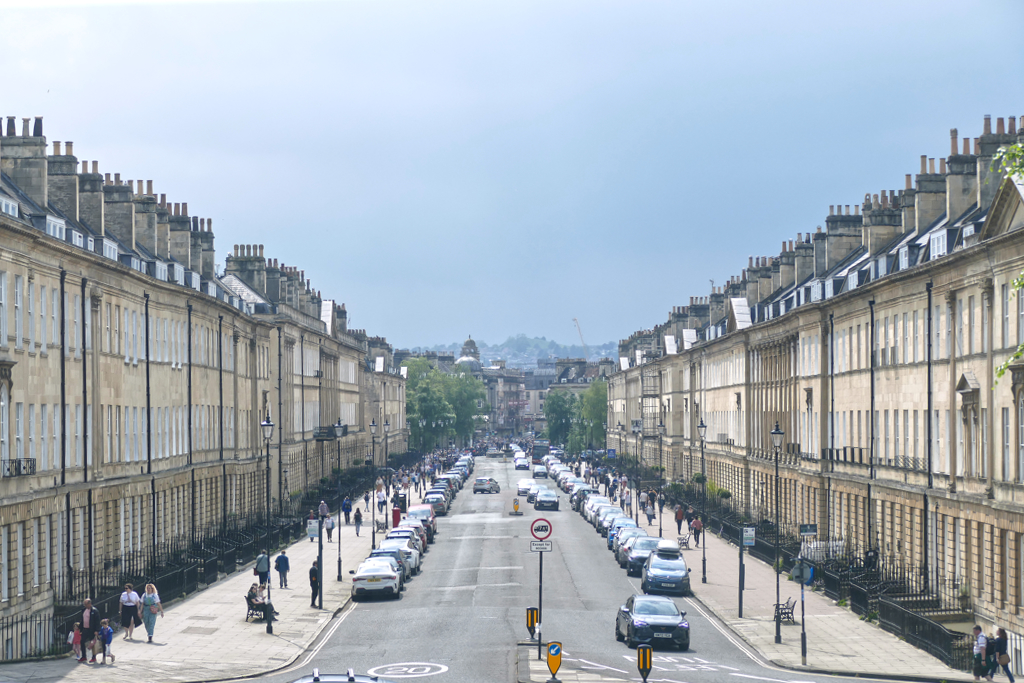
At around 300 meters long and 30 meters wide, the street is the widest and grandest in Bath. It is lined with a symmetrical row of houses. Baldwin only designed the uniform façades of the buildings. The owners of the individual units created the actual structures behind those frontwalls. Hence, although the street has a uniform appearance, the buildings inside are individually designed.
Sir William Pulteney was very rich. And like many of his contemporaries, he made most of his fortune in the West Indies through slave labor. For this reason, the Black Lives Matter movement questions whether the boulevard should be renamed.
The Holburne Museum
At the end of the Great Pulteney Street stands the Holburne Museum which unfortunately also reminds us of the fact that Bath’s lavish lifestyle was partly financed by blood money.
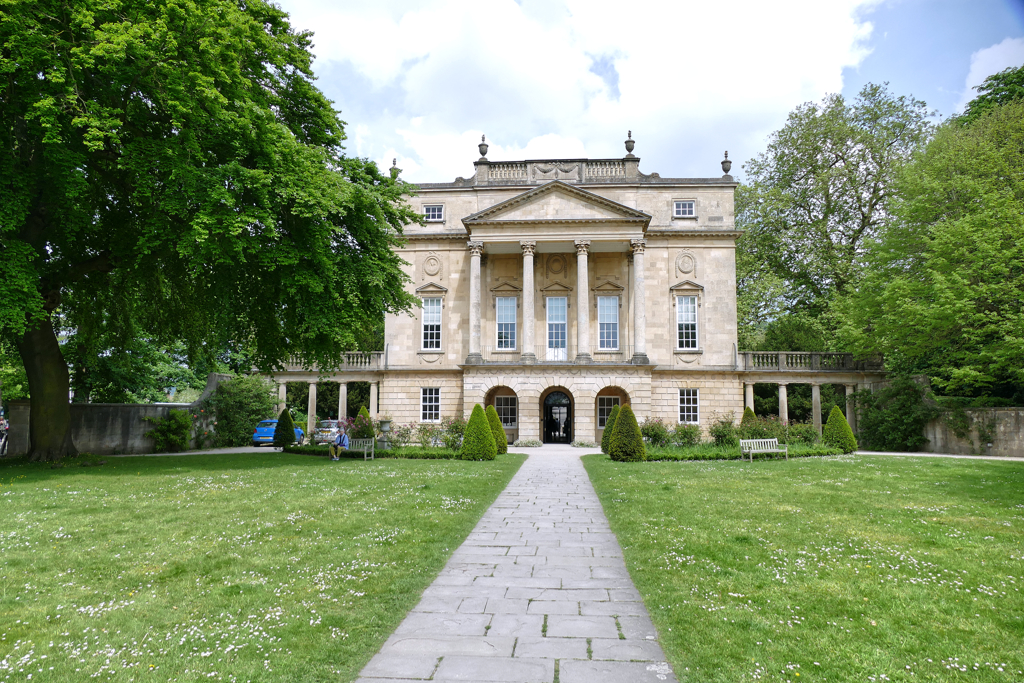
Since 1916, the museum has been housed in the former Sydney Hotel. Architect Thomas Baldwin planned the hotel and the pleasure gardens in the back in 1794. Due to his bankruptcy, the design was never implemented. Instead, Charles Harcourt Masters created a three-story building that was completed in 1799.
The Sydney Gardens, which were only accessible through the hotel, were reportedly Jane Austen’s favorite walking grounds. Today, the gardens are the only remaining 18th-century pleasure gardens in all of Britain!
As Seen in the Movies
Like many of Bath’s magnificent buildings, the Holburne Museum has served as a backdrop for numerous films such as The Duchess with Keira Knightley, Vanity Fair with Reese Witherspoon, as well as many other television and film productions.
It will come as no surprise that the building also appears in the Netflix series Bridgerton and the spin-off Queen Charlotte.

In the center is a portrait of the Byam Family, created by Thomas Gainsborough. These good people were landowners in Antigua. They owned 132 slaves who were working on their vast sugar plantations.
In fact, the Holburne Museum has been Bath’s first public art museum. The core of the collection came from Sir Thomas William Holburne. It includes works by Gainsborough, Stubbs, Ramsay, and Zoffany, to name just a few. Just for the record: The Holburne family was part of the British elite who had gained most of their wealth from the transatlantic slave trade. In other words, Holburne’s cultural wealth was financed by slave labor.
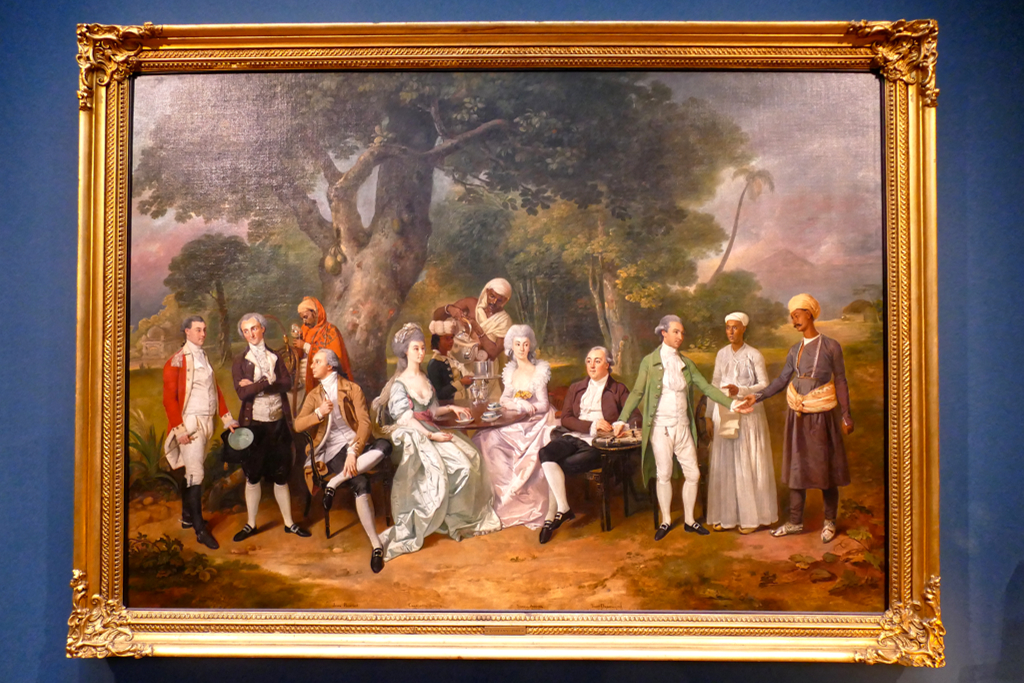
The servants and slaves in the picture caught the attention of the artist, who wants to use her installation to point out that worldwide, around 50 million people still live in slavery today. Unfortunately, Csosz’s work could not be photographed due to the lighting conditions. But if you visit the Holburne Museum, you should definitely look out for it.
The Holburne Museum is open from Monday to Saturday between 10 a.m. and 5 p.m. On Sundays, they are opening only at 11 a.m. The general entrance fee is £11.
Sally Lunn’s Historic Eating House
Phew, who knew there was so much to explore in Bath? After three complete tours with the Tootbus**, long walks up and down the sometimes steep streets in the center, looking for art and culture, history and stories, it was finally time to take a culinary break. And Bath wouldn’t be Bath if even a snack came with a sack of history: The most idyllic spot for a classic teatime is Sally Lunn’s Historic Eating House, tucked away in the narrow North Parade Passage.
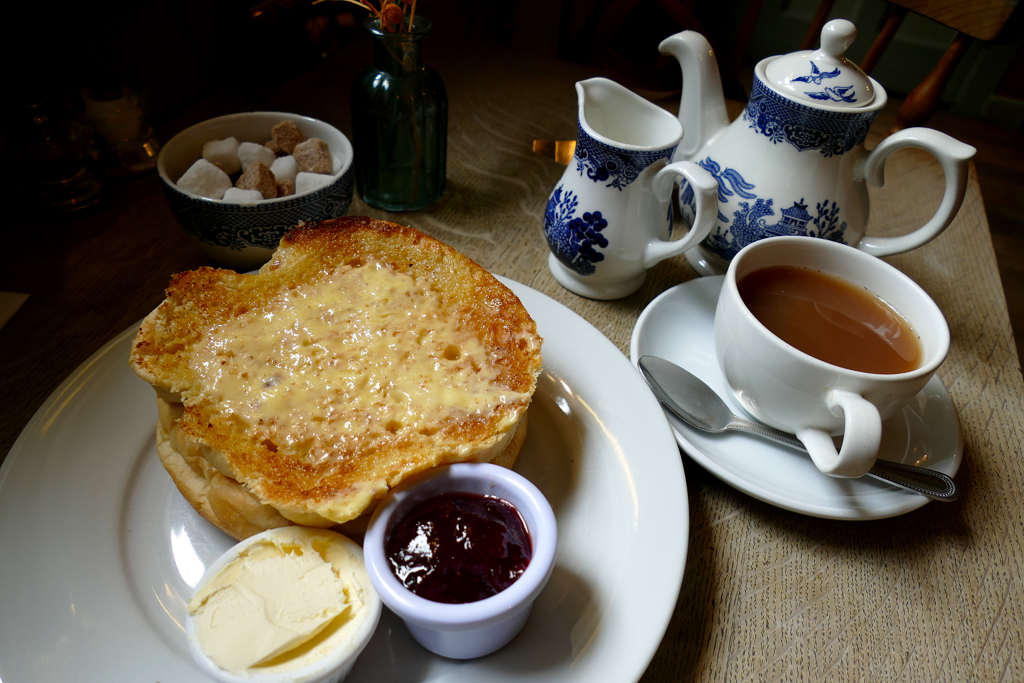
Sally Lunn’s is more than a popular teahouse. Housed in one of Bath’s oldest houses, it is a true institution. Only here can you get the real Sally Lunn bun for tea. A cream tea usually comes with only half the roll. That sounds chintzy. However, as soon as you see it on the plate in front of you, you’ll reconsider: This half alone has a diameter of over 15 centimeters and is almost 5 centimeters thick. In other words: That thing is huge!
The consistency is similar to French brioche. The bun is served warm and generously buttered, accompanied by jam and clotted cream.
A real treat!
Legend Has It
The Sally Lunn Eating House claims that the recipe was brought to Bath in the 1680s by a Huguenot refugee named Solange Luyon.
It’s a cute story, but there’s no evidence for it.
What is proven though, is that the building stands in a spot where the southern part of Bath Abbey was located. Hence, the lowest floor dates from the time of the abbey’s reconstruction after a major fire in 1137. Either way, the building is one of the oldest in the city.
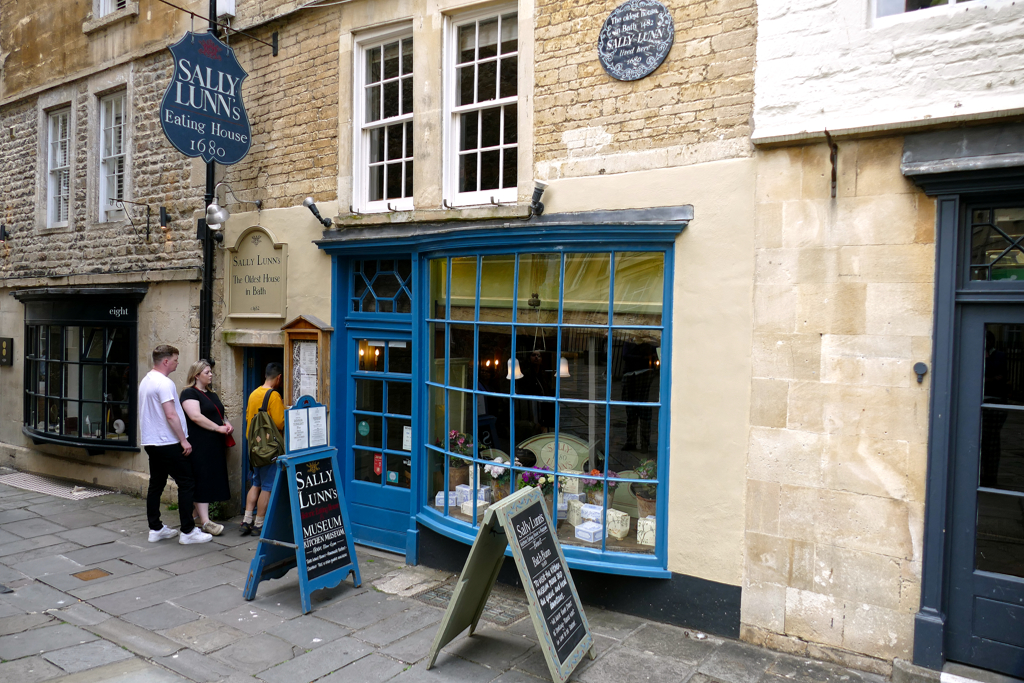
Sally Lunn’s is open every day from 10 a.m. to 9 p.m. A daytime menu including various teatime options is served until 6 p.m. At 5 p.m., they start to serve dinner, and that’s the only time when you can make reservations. Their so-called kitchen museum can be visited every day from 10 a.m. to 4 p.m., Saturdays until 6 p.m.
Practical Information
How to Get There
Air Travel
Bath does not have an airport, obviously. The closest one is at Lulsgate Bottom, about 13 kilometers southwest of the city of Bristol and less than 30 kilometers west of Bath. It is in fact the eighth busiest airport in the United Kingdom, served mostly by EasyJet and RyanAir.

However, there are three scheduled flights between Amsterdam and Bristol operated by KLM, and according to my experience, this is a hot mess! KLM canceled my outbound flight 45 minutes before the scheduled departure by sending me a brief Email, rescheduling my flight 48 hours later. I still wonder, what were they thinking? Finally, they sent me the following day crisscross Europe before I finally made it home. My conclusion: Never again!
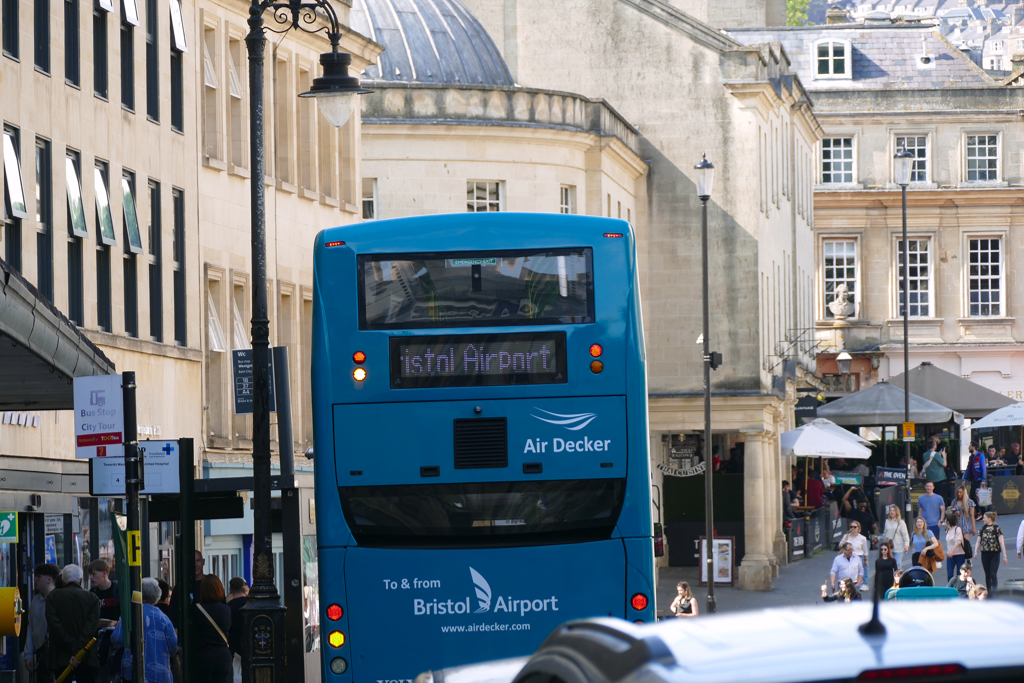
This being said, I have rarely experienced an airport being reached so quickly and so reliably. The A4 Air Decker A1, which absolutely lives up to its name, runs every hour almost around the clock. Therefore, I would argue there is no reason to take a cab. A one-way trip costs £16.50, and a round trip sets you back £22. The return trip must be made within three months. Obviously, there is also a so-called Airflyer A1 going to Bristol from where you can take a train to Bath.
Land Travel
Talking ’bout trains: They are the best option when you are already in Great Britain. From the Paddington Station in London, it takes around 75 minutes and tickets start at £24. From Bristol, there are trains about every 15 minutes. The ride takes ten to twenty minutes and during off-peak hours, a return trip costs as little as £9.80.

An alternative is travelling by long-distance bus, obviously. The National Express travels from London‘s Victoria Coach Station to Bath Spa Bus Station up to 14 times a day, however, the ride takes almost three hours and tickets start at £7.
How to Get Around
It depends a bit on what you are planning on doing. If you want to stay in the very center of the city, walking is your best option. Of course, there is inner-city transport in Bath, but the buses don’t necessarily take you to the places of tourist interest. Also, large parts of the inner city are traffic-calmed, hence, the public buses can only take you so far.
Cycling might be an option, however, the narrow cobblestone streets are packed with people. Also, some of the most alluring streets are quite steep. To me, this deems rather a challenge than fun. Of course, things are completely different if you want to explore Bath’s beautiful surroundings. In this case, a bike is certainly a valid option. However, you should keep in mind that the landscape around the city is hilly and the roads are often very steep. A good place to rent E-bikes is Julian House Bike Workshop.
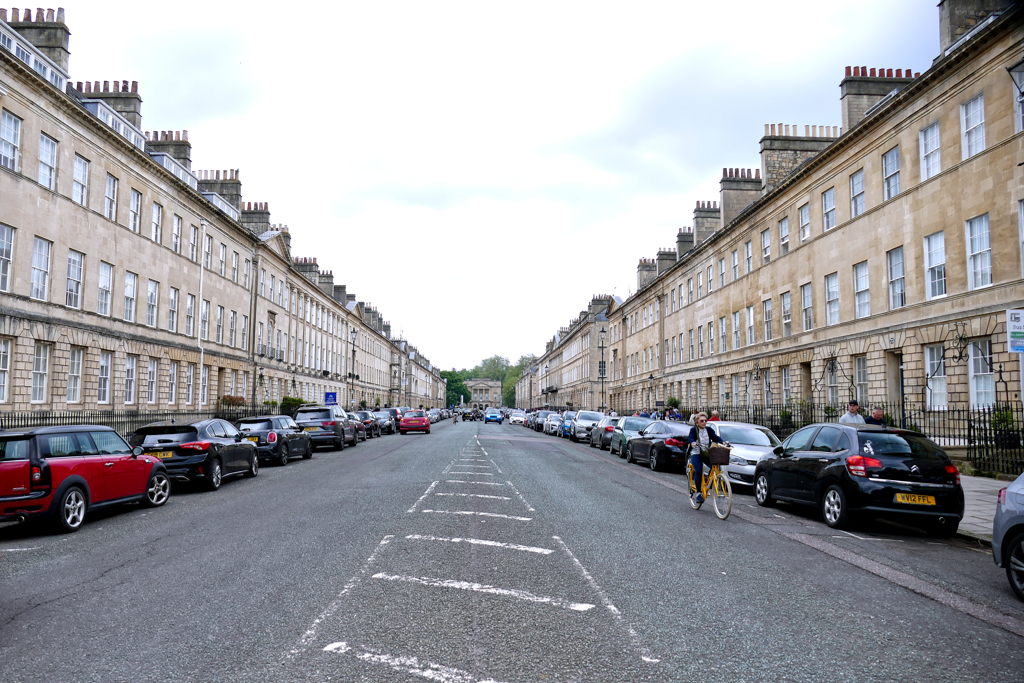
This being said, the touristy Tootbus** is your best option especially if you only have one day in Bath. Agreed, the day ticket is significantly more expensive than the fare for the public bus. But you can get on and off as often as you want, and the Tootbus** goes to all tourist-relevant places in the city and the surrounding area.
Communication
Since June 2017, no roaming charges have applied within the EU with a European mobile phone contract. This applies in all 27 countries of the European Union as well as in Iceland, Liechtenstein, Norway, and Great Britain – temporarily even after Brexit.

Obviously, you can connect to the internet without any issue at basically every museum, eatery, or café, and, of course, your hotel.
If you insist on being online 24/7, you can get a SIM card, obviously. However, not every card that you buy in the UK will offer free EU roaming! EE and Three UK still offer this service, O2 only on some of their plans, and Vodafone UK doesn’t offer it at all. Hence, if you intend to use your local SIM card also in continental Europe, you have to check your options very thoroughly.
Visiting Organized
Although I’m an avid solo-travelling woman, I sometimes like to join organized tours. Not only are they a valid option to go to remote places since I’m not driving. They also allow me to enjoy the company of fellow travellers.
Tour agencies like GetYourGuide** offer various themed tours of Bath at a reasonable price. Here are some more great ideas of what to do during your visit. But bear in mind that especially during high season, pre-booking online will guarantee your place at the activity of your choice**:
Where to Sleep
As many do, I visited Bath on a day trip during a long weekend in Bristol. However, if I had more time I would have loved to spend at least one night in Bath. Simply because I am a big fan of SPA treatments and a soak in the pool on the roof terrace of the Thermae Bath Spa must be an unforgettable experience.
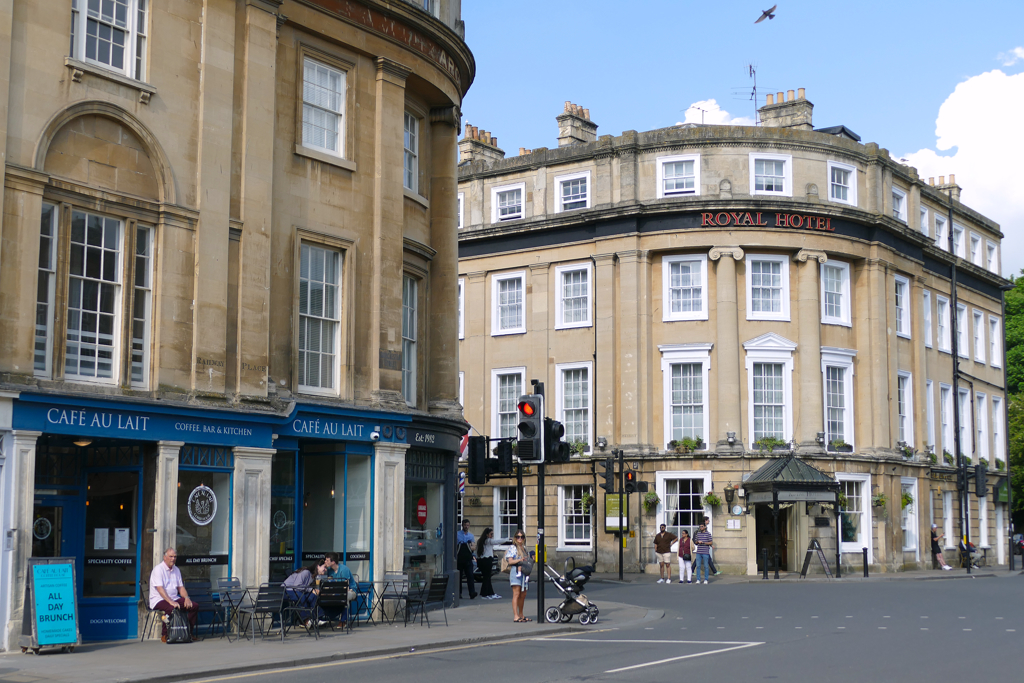
An overnight stay is also recommended so that you can be one of the first at the entrances to the most popular attractions without stress. Hence, if you want to stay in Bath, you can use this map to find places to stay that suit your needs and budget**:
Where to Eat
I’m not usually one of those people who crave a snack as soon as they arrive at a destination. But to make it to the Roman Bath as early as possible, I had left Bristol before breakfast. Hence, on arrival, I was in desperate need of coffee and a snack that would fuel me for an exciting day in the city.
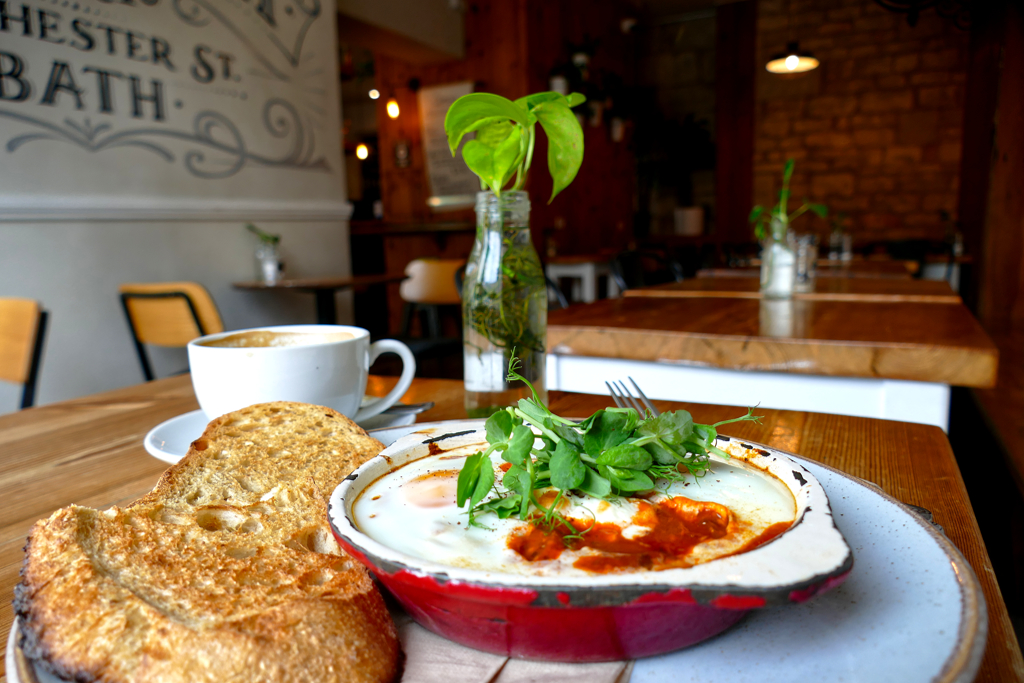
Luckily, these are two wishes that are very easy to fulfill in England as there are tons of cafés and restaurants serving all kinds of breakfasts.

One of the nicest ones is waiting for the hungry daytripper right across from the train station: They have a wide range of sweet and savory breakfast options which is accompanied by strong coffee or other delicious drinks of your choice.

If you need a snack during the day and don’t want to spend time at a restaurant, you can always grab a traditional snack at the small market within the Guildhall. I opted for a traditional kidney and steak pie that I later enjoyed during a short picnic at the Royal Victoria Park in front of the Royal Crescent. A truly British experience at a very small cost.
Map
On this map, you can see where to find all the places I’m mentioning in this post. Clicking on the slider symbol at the top left or the full-screen icon at the top right will display the whole map.
Pinnable Pictures
If you choose to pin this post for later, please make sure to use one of these pictures:
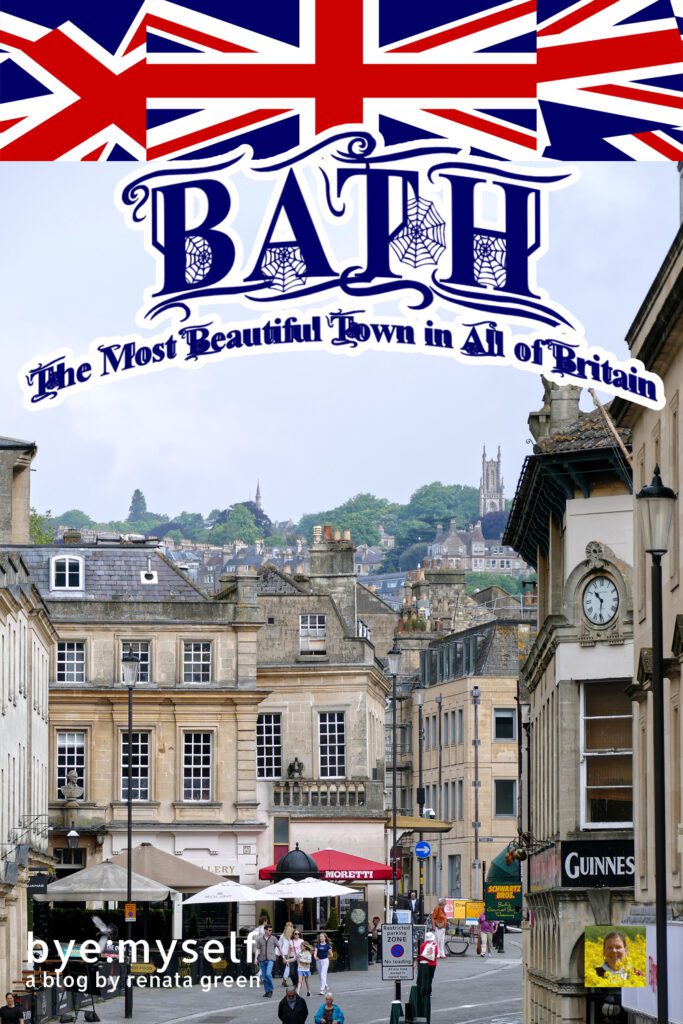
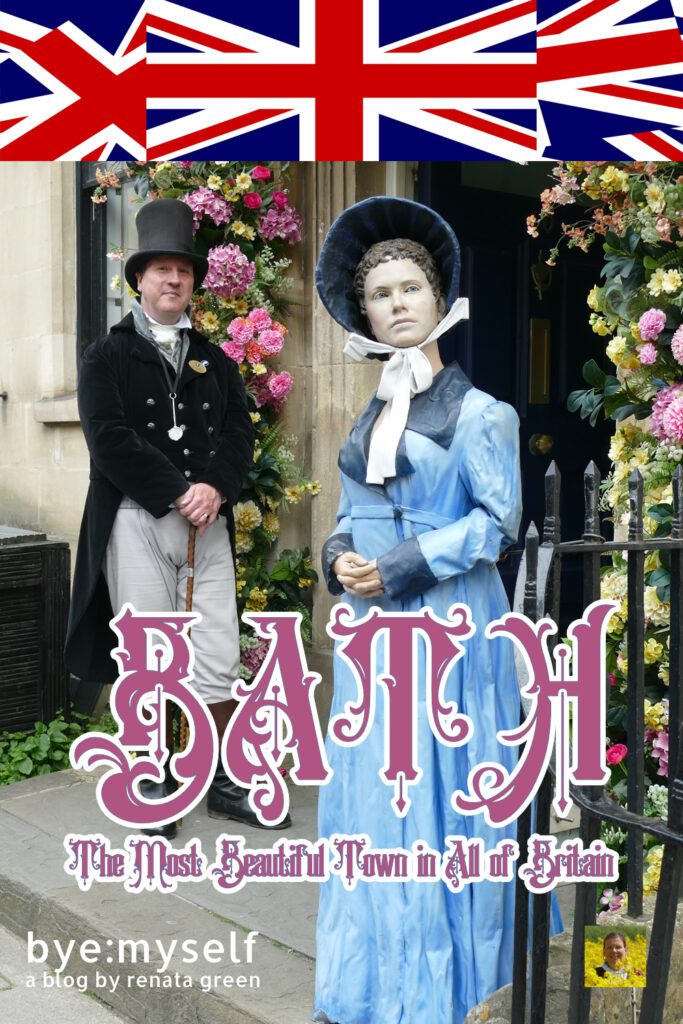
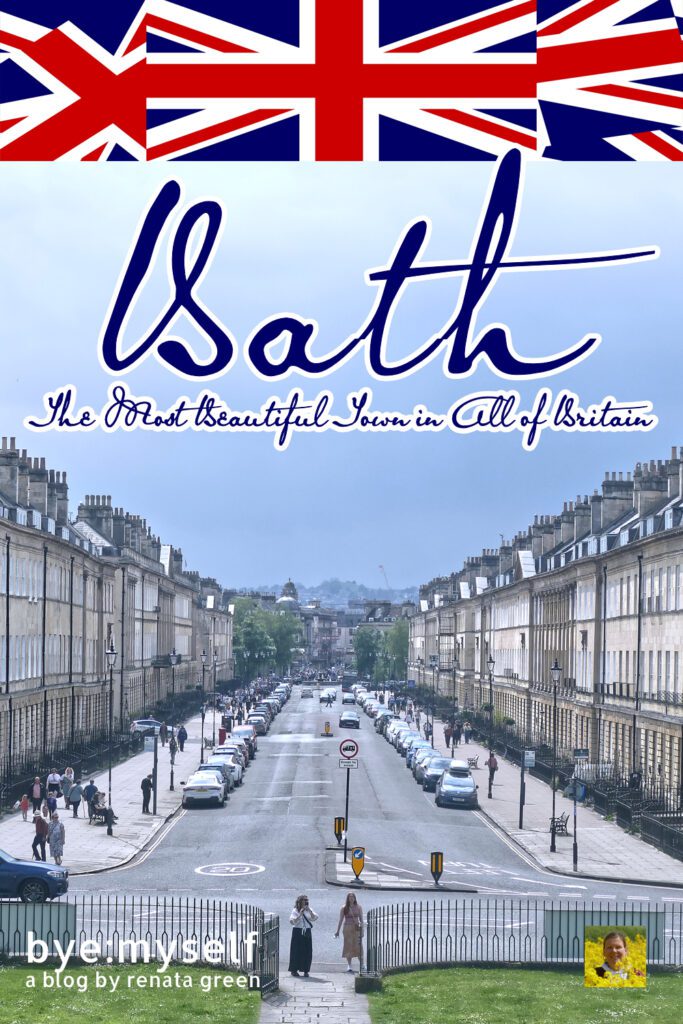
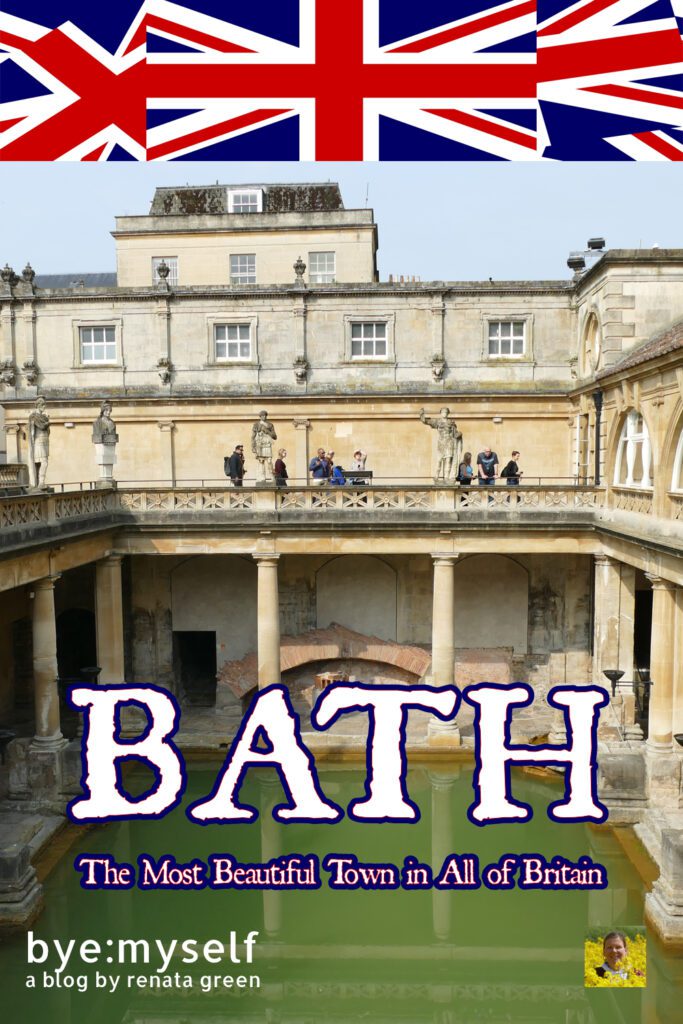

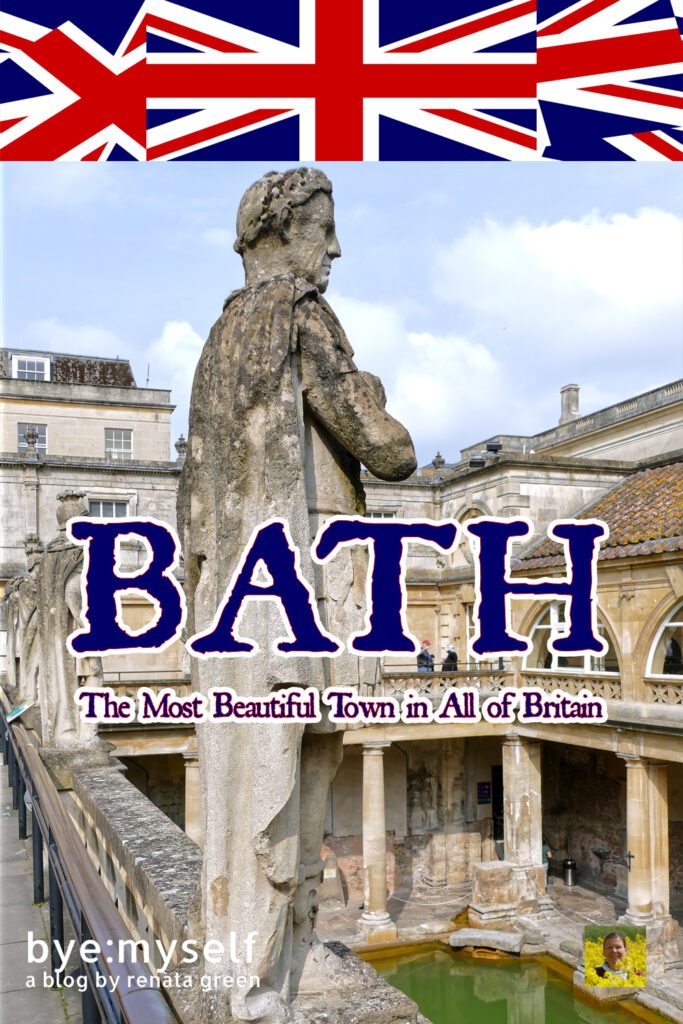
Did You Enjoy This Post? Then You Might Like Also These:
LONDON – Off the Beaten Path
Best Street Art in BRISTOL – Part II: North Street
Best Street Art in BRISTOL – Part I: From Nelson Street to Stokes Croft
A Day in BATH, the Most Beautiful Town in All of Britain
24 hours in LONDON
BRISTOL – What to Do on the Best Weekend Break You’ll Have in a Long Time
Best Street Art in LONDON – Part I: Camden
Best Street Art in LONDON – Part II: Shoreditch
* Disclaimer: I am very appreciative that http://visitwest.co.uk | http://visitbristol.co.uk | http://visitbath.co.uk supplied me with complimentary Media Passes. Also, Sally Lunn’s Tea Room & Restaurant treated me to a lovely Tea Time. Nevertheless, the description of all activities as well as opinions on services are mine and were in no way influenced by my cooperation partners.
** This is an affiliate link. Hence, If you book through this page, not only do you get the best deal. I also get a small commission that helps me run this blog. Thank you so much for supporting me!
